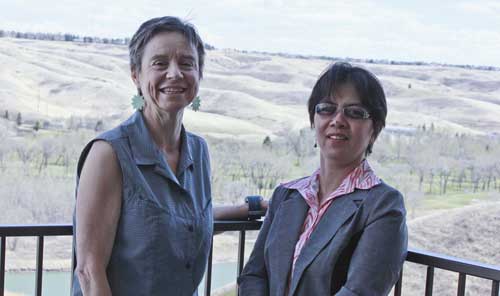Established by the Vice-President Research, the Interdisciplinary Research Development Fund (IRDF) is a one-time non-renewable research fund that will provide the foundation for developing the next generation of interdisciplinary concentrations of research excellence at the University of Lethbridge. The General Faculties Council Research Committee reviewed applications for IRDF funding and three proposals received support (up to $100,000 each over two years). This is one of three projects funded in 2012.
The title of their project might be long, but five University of Lethbridge researchers are hoping their work leads to more concise ways in which disadvantaged groups, in particular women, can benefit from having input into, and influence over, social programs designed to assist them.
The research team, comprised of Dr. Carol Williams and Dr. Glenda Bonifacio of the department of Women and Gender Studies, Dr. Patrick Wilson of the Department of Anthropology, Dr. Bonnie Lee of the Faculty of Health Sciences (addictions counselling) and Linda Many Guns of the department of Native American Studies recently received nearly $100,000 from the U of L Interdisciplinary Research Development Fund (IRDF) to explore a project entitled Creative Appropriations: Identities, Communities, and Development in Cross-Cultural and Interdisciplinary Perspectives.

Simply put, the researchers are looking at how their target groups have been constructed by the state, appropriate the policies and programs directed at them by government or social agencies and how their particular cultural and lived experiences challenge these constructions to demonstrate alternative models of civic engagement.
The project, suggests Lee, "may shed light on how government policies and non-government organizations (NGOs) can be better positioned to promote more inclusive and vibrant communities."
"This multi-faceted research project will allow us to better understand the possible implications of state and NGO programs for minority populations, and may help us to question the cultural and ideological impulses driving the design of certain projects," says Williams.
Wilson notes the results may, "allow us to see the ways in which minority women, in this case, navigate sometimes hostile policy environments and therefore our results may allow for better design and planning of those policies and programs themselves. Better yet, it may encourage a shift in the control of a project's design and implementation back to local communities and stakeholders."
The local communities and stakeholders aren't just from one particular group. The researchers will be talking with indigenous women involved in food sovereignty projects in Ecuador, women and women's organizations in First Nations communities in Canada and the United States and racialized immigrant women in Canada.
Very little comparative scholarship on the circumstances of racialized immigrant and indigenous women currently exists.
Through a combination of research methods, they hope to gain a clearer picture of some of the challenges or barriers women face in developing cultural or other programming, how they worked creatively to overcome them and how they engaged in 'creative appropriation' to make projects work better.
"An agency might give a group funds, or design a social program for one specific purpose," says Williams.
The group, in turn, might use the money for that stated purpose, or creatively expand the bounds of the agency's funding or program parameters. Williams says that sometimes those groups who work creatively to help their constituents can find themselves 'de-funded' if they stray too far from the stated plan set out by the group or governing organization overseeing the project.
"We are hoping to collect information which can contribute to a new way of policy-making for organizations that allows for, as we're calling it, the 'creative appropriation' of a program design or funding process to make it their own, and possibly more effective."
This story first appeared in the May issue of the Legend. For a look at the full issue in a flipbook format, follow this link.
